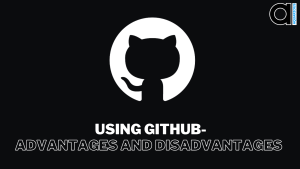Using GitHub- Advantages and Disadvantages

In the realm of software development and collaborative coding, GitHub stands as a prominent platform that has revolutionized the way developers work together on projects. With its suite of tools for version control, collaboration, and project management, GitHub has become an integral part of the developer’s toolkit. However, like any tool, there are advantages and disadvantages of using GitHub. This article will delve into the advantages and disadvantages of using GitHub.
What is GitHub?
GitHub is a web-based platform that provides a powerful set of tools for developers to manage and collaborate on software projects. It is built around Git, a distributed version control system developed by Linus Torvalds, the creator of Linux. Git allows multiple developers to work on the same project simultaneously, tracking every change made to the codebase.
GitHub takes Git a step further by offering a user-friendly interface and a range of features that enhance collaboration and project management. It provides a platform for hosting code repositories, enabling developers to store, manage, and track project changes. In this article, we look into the advantages and disadvantages of using GitHub.
Why is GitHub Used?
Efficient Version Control:
GitHub’s core functionality is centred around version control. It allows developers to track changes, compare versions, and revert to previous states of the codebase. This ensures that the entire development team is working on the most up-to-date version of the project.
Collaborative Workflow:
GitHub facilitates seamless collaboration among developers. It allows forking of repositories, enabling developers to create their own versions of a project. Once changes are made, a pull request can be submitted to merge those changes back into the original codebase. This process promotes teamwork and ensures that only thoroughly reviewed and approved code is integrated.
Easy Issue Tracking and Management:
GitHub provides a robust issue tracking system. This allows teams to create, assign, and prioritise tasks. Developers can discuss issues, propose solutions, and link them to specific branches or pull requests. This feature streamlines project management and ensures that nothing falls through the cracks.
Documentation and Wikis:
GitHub offers a built-in wiki system, allowing developers to create detailed documentation for their projects. This helps in maintaining a clear and accessible knowledge base, making it easier for team members to onboard and for external contributors to understand the codebase.
Continuous Integration and Deployment (CI/CD):
GitHub Actions, a feature integrated into the platform, allows for the automation of workflows, including testing, building, and deploying code. This supports the practice of continuous integration and deployment, increasing the efficiency of the development process.
Strong Community and Open Source Contributions:
GitHub has an expansive community of developers and a vast repository of open-source projects. This provides an opportunity for collaboration, learning, and contributing to various projects. Developers can leverage this community to seek help, share knowledge, and find solutions to common coding challenges.
Additional Features of GitHub
Code Review Capabilities:
GitHub provides a seamless code review process. Team members can comment on specific lines of code, suggest changes, and approve or request revisions to pull requests. This ensures that code is thoroughly reviewed before integration.
Integration with Third-party Tools:
GitHub offers a wide range of integrations with popular third-party tools and services. This includes tools for project management, continuous integration, testing, and deployment, allowing teams to customise their workflows to suit their specific needs.
Insights and Analytics:
GitHub provides insights into the development process through features like code frequency, contributors, and pulse. These analytics can help teams track progress, identify areas for improvement, and make informed decisions about project direction.
Disadvantages of Using GitHub
Learning Curve for Beginners:
For novice developers, Git and GitHub can initially be daunting. Understanding concepts like branches, commits, and pull requests may take some time. This learning curve can potentially slow down the onboarding process for new team members.
Dependency on Internet Connection:
GitHub is a cloud-based platform, which means it relies heavily on a stable internet connection. This can be a limitation in areas with unreliable or slow internet access. Moreover, if GitHub experiences downtime, it can disrupt the development workflow.
Limited Privacy for Free Accounts:
Free GitHub accounts have limitations on private repositories. This means that for projects requiring confidentiality, developers may need to opt for a paid subscription, which may not be feasible for individuals or small teams with limited resources.
Potential for Over-Reliance on GUI:
While GitHub provides an intuitive web interface, developers may become overly reliant on it. This can lead to a lack of proficiency in using Git from the command line, which is a valuable skill, especially for more complex workflows.
Vendor Lock-In:
Since GitHub is a proprietary platform that Microsoft owns, there is a degree of vendor lock-in. Moving projects to an alternative platform can be a complex process, and developers may find it challenging to transition away from GitHub if they encounter compatibility issues.
Security Concerns:
Although GitHub employs robust security measures, there is always a potential risk associated with hosting code on a third-party platform. Organizations with sensitive or classified projects may have reservations about using a cloud-based service for their repositories.
Lack of Integrated Project Management Tools:
While GitHub provides excellent version control and collaboration features, it may not be as comprehensive in terms of project management tools compared to dedicated project management platforms. This may require teams to use additional tools for tasks like resource allocation, time tracking, and progress tracking.
In conclusion, GitHub undeniably offers a plethora of advantages for developers and teams working on collaborative projects. Its efficient version control, collaborative workflows, and community support are invaluable assets. Additionally, GitHub provides a range of features such as code review capabilities, integration with third-party tools, and insights and analytics to enhance the development process. However, it is essential to be aware of the potential disadvantages, such as the learning curve, reliance on an internet connection, privacy limitations, vendor lock-in, security concerns, and the need for additional project management tools. By weighing the advantages and disadvantages of using GitHub, developers can decide whether GitHub is the right tool for their specific projects and teams.
-
14
+Category
-
98
+Post
Top Categories
Popular Posts
- The Power of Prototyping in Software Development
- Version Control Best Practices for App Development
- Understanding Visual Hierarchy: A Guide to Effective Design
- Crafting Intuitive Navigation: A Guide to Seamless User Experience
- Choose Your Best Cloud Provider
- Making the Leap: Transitioning from Manual to Automated Software Testing
- Using GitHub- Advantages and Disadvantages
- E-commerce Product Photography on a Budget
- Tech Innovation in Developing Countries
- Smart Cities: How Technology is Shaping the Urban Landscape
- Principles of Composition: Creating Visual Harmony with Composition
- Exploring Cross-Platform App Development
- Why Regular Website Updates Matter
- Navigating Effective Facebook Audience Targeting
- Implementing Ads for Game Monetization
- Designing User-Centric Mental Health Apps: Enhancing Well-being in the Digital Age
- NFTs and Collectibles: Creating NFT App Solutions for Collectors and Enthusiasts
- Successful Implementation of Enterprise Apps
- Maximizing Business Impact with EQ
- Proven SMO Ads Optimization Tips (2023)






